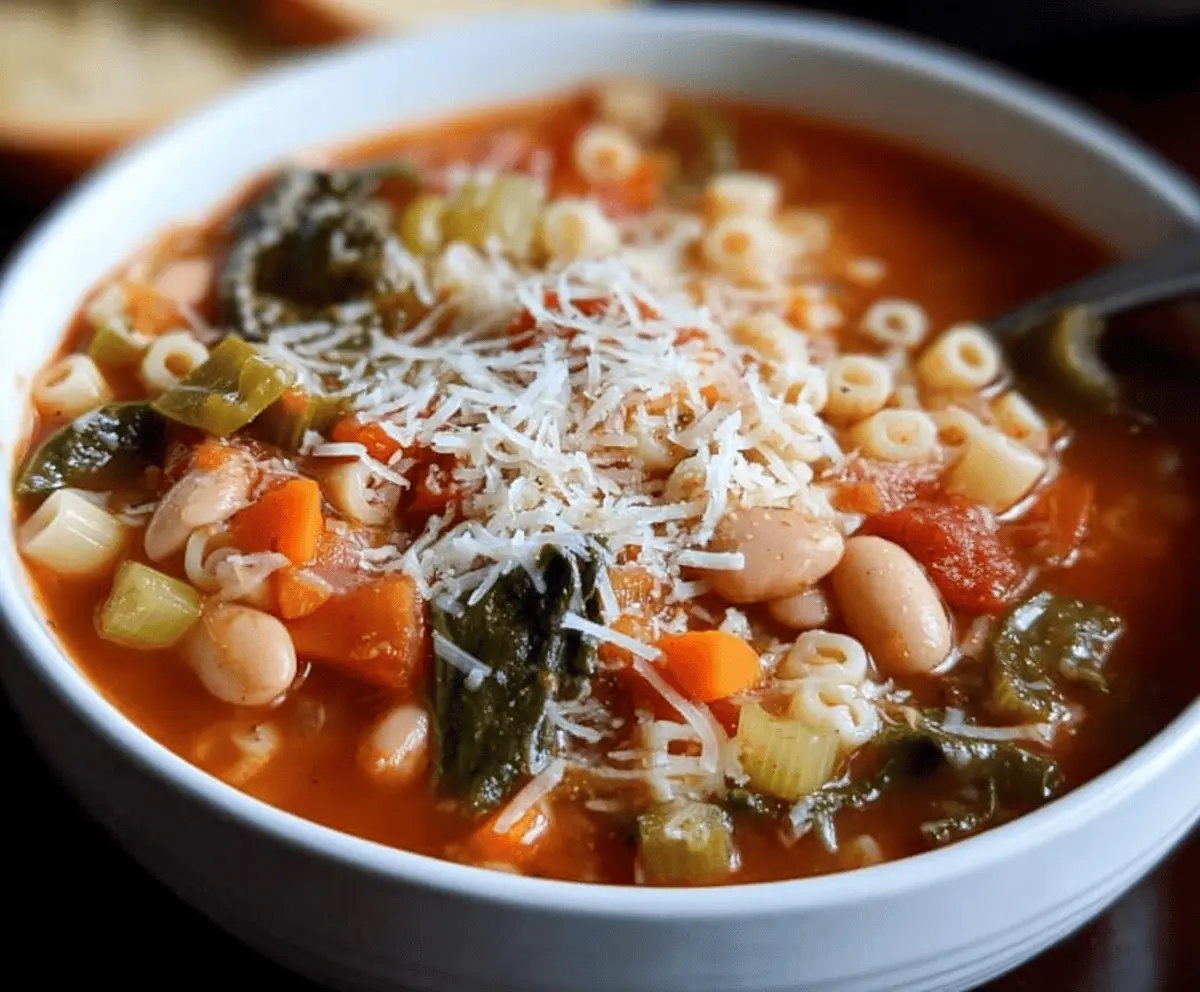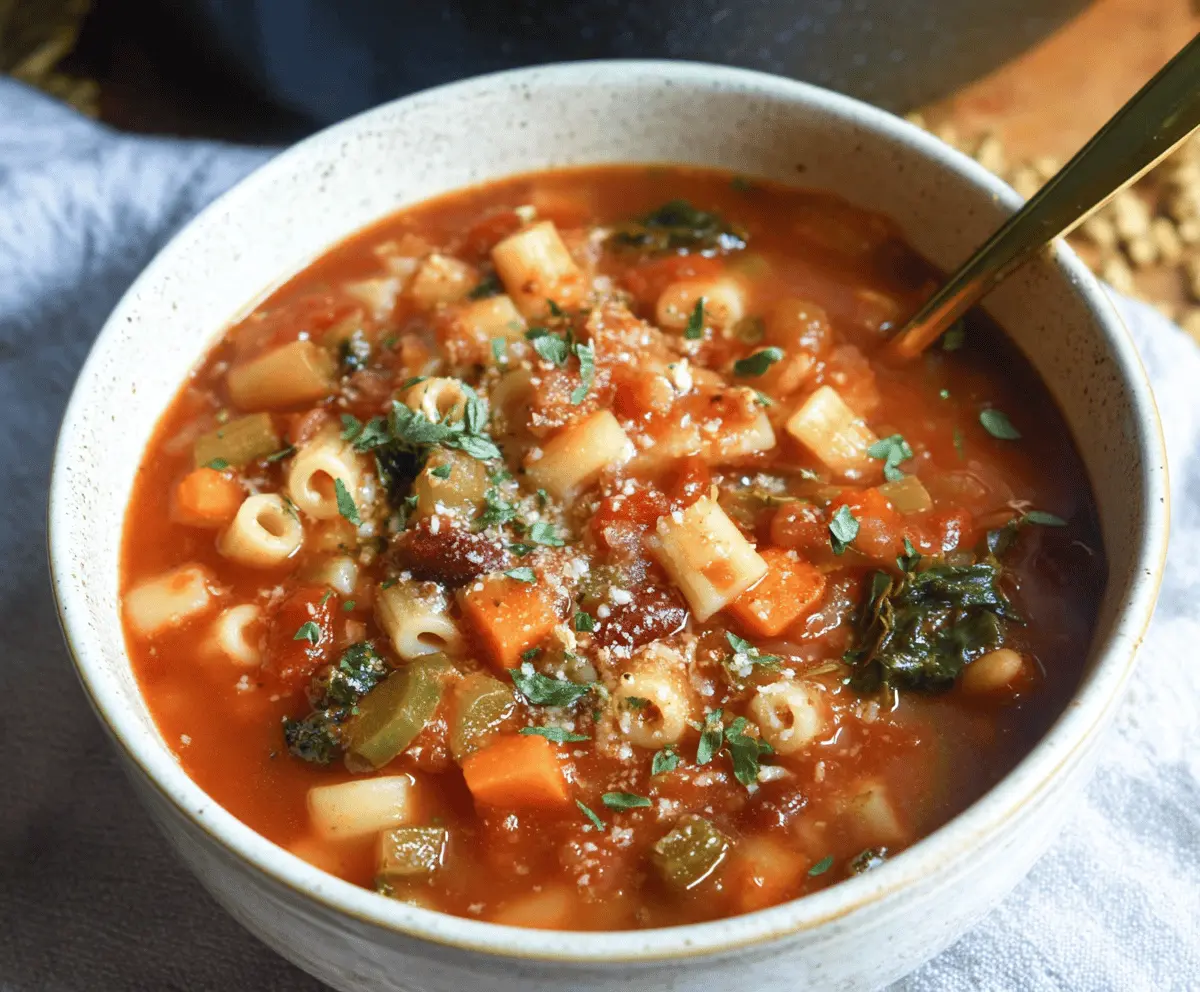Classic Minestrone Soup is a hearty and colorful mix of fresh vegetables, beans, pasta, and a rich tomato broth. It’s the kind of soup that feels like a warm hug in a bowl, packed with flavors and textures that are both comforting and satisfying. You’ll find carrots, celery, zucchini, kidney beans, and tiny pasta shapes all mingling together in this filling Italian favorite.
I love making this soup on chilly days when I want something that’s healthy and filling but still vibrant and fresh. What’s great about minestrone is how flexible it is—you can toss in whatever vegetables you have on hand, making it perfect for using up leftovers. I always add a little extra garlic and herbs for that cozy, home-cooked taste.
My favorite way to enjoy classic minestrone is with a slice of crusty bread or a sprinkle of Parmesan cheese right on top. It’s a wonderful meal on its own but also pairs nicely with a simple green salad. Whenever I serve this soup, people can’t get enough of it—it’s like a little bowl of sunshine, even on the dreariest days!
Key Ingredients & Substitutions
Olive oil: This is your base for sautéing veggies. Extra virgin olive oil adds a nice, mild flavor. If you don’t have it, any neutral oil like canola or avocado oil works.
Vegetables: The mix of onion, carrot, celery, zucchini, and potato gives the soup its classic texture and taste. Feel free to swap in seasonal veggies like bell peppers or green beans.
Beans: Cannellini or kidney beans add protein and creaminess. Canned beans are easy, but dried beans soaked and cooked work too. For variety, try chickpeas or black beans.
Greens: I like kale for its hearty texture, but spinach is a great mild option if you prefer something tenderer.
Pasta: Small shapes like ditalini or elbow macaroni are traditional because they fit in a spoon nicely. Gluten-free pasta is a good swap if needed, just watch the cooking time.
Herbs & seasoning: Dried oregano and basil give that Italian flavor, but fresh herbs like thyme or rosemary can be a nice change. Always taste and adjust salt and pepper at the end.
How Do I Get the Vegetables to Cook Perfectly Without Getting Mushy?
The secret is layering your cooking times for each vegetable, so none gets overcooked or too soft:
- Start by sautéing onions until translucent for a flavor base.
- Add carrots and celery next—they’re tougher and need a bit longer.
- Then stir in zucchini and potatoes; they cook faster and can get mushy.
- Simmer with broth and tomatoes to combine flavors and finish cooking vegetables gently.
- Add quick-cooking greens at the end to keep their fresh texture and color.
Taking these steps helps keep every bite of your minestrone just right—soft, but with some bite. Patience while simmering lets the flavors blend without turning everything to mush!

Equipment You’ll Need
- Large heavy-bottomed pot – It’s perfect for simmering the soup evenly without burning.
- Cutting board and sharp knife – For chopping all the vegetables with ease.
- Wooden spoon or spatula – Great for stirring and scraping the bottom as the soup cooks.
- Measuring spoons and cups – To get the seasoning and ingredients just right.
- Wooden or metal ladle – For serving the hearty soup hot and easily.
Flavor Variations & Add-Ins
- Protein boost: Add cooked sausage, chicken, or even bacon bits to make it more filling.
- Cheese: Stir in a handful of grated Parmesan or Pecorino for extra richness.
- Extra greens: Toss in some frozen peas or green beans near the end for more color and nutrition.
- Herb twist: Finish with fresh basil, thyme, or a sprinkle of red pepper flakes for added flavor and spice.

Classic Minestrone Soup
Ingredients You’ll Need:
- 2 tablespoons olive oil
- 1 medium onion, diced
- 2 cloves garlic, minced
- 2 medium carrots, diced
- 2 celery stalks, diced
- 1 zucchini, diced
- 1 medium potato or sweet potato, diced
- 1 cup kale or spinach, chopped
- 1 can (14.5 oz) diced tomatoes
- 1 can (15 oz) cannellini or kidney beans, drained and rinsed
- 6 cups vegetable broth
- 1 teaspoon dried oregano
- 1 teaspoon dried basil
- Salt and freshly ground black pepper, to taste
- 3/4 cup small pasta (such as ditalini or small elbow macaroni)
- Fresh parsley, chopped (for garnish)
- Grated Parmesan cheese (optional, for garnish)
How Much Time Will You Need?
This soup takes about 10 minutes to prep your vegetables and another 35 minutes to cook everything together. So, in total, plan for around 45 minutes from start to finish. It’s quick for a homemade soup and fills the kitchen with wonderful aromas!
Step-by-Step Instructions:
1. Cooking the Base Vegetables:
Warm the olive oil in a large pot over medium heat. Add the diced onion and cook until it’s soft and clear, about 4-5 minutes. Then add garlic, carrots, and celery, stirring and cooking for another 4-5 minutes until they start to soften.
2. Adding More Vegetables:
Stir in the zucchini and diced potato. Let these cook together for about 2 minutes so they start to soften up.
3. Building the Soup:
Add the canned diced tomatoes with their juice, the vegetable broth, oregano, basil, salt, and pepper. Bring the mix to a boil, then lower the heat and let it simmer gently for about 20 minutes until the veggies are tender and flavors have blended.
4. Final Touches:
Mix in the rinsed beans and chopped kale or spinach, cooking for about 5 minutes until the greens wilt. Then add the pasta and cook until it’s just tender, around 8-10 minutes, depending on the pasta’s instructions.
5. Serving:
Taste the soup and add extra salt or pepper if needed. Serve it warm, topped with fresh parsley and a sprinkle of Parmesan cheese if you like. It pairs wonderfully with crusty bread for a complete meal.
Equipment You’ll Need
- Large heavy-bottomed pot
- Cutting board and sharp knife
- Wooden spoon or spatula for stirring
- Measuring cups and spoons
- Ladle for serving
Flavor Variations & Add-Ins
- Protein: Add cooked sausage, shredded chicken, or crispy bacon bits to make it heartier.
- Cheese: Stir in grated Parmesan or Pecorino for richness.
- Extra veggies: Toss in frozen peas, green beans, or bell peppers near the end for extra color and nutrition.
- Herbs and spice: Finish with fresh basil, thyme, or a pinch of red pepper flakes for a little heat.
Can I Use Frozen Vegetables in Minestrone Soup?
Absolutely! Frozen vegetables are a great time-saver. Just add them a bit later in the cooking process since they cook faster than fresh. For example, toss in frozen zucchini or peas during the last 5-10 minutes of simmering.
How Can I Make Minestrone Soup Gluten-Free?
Simply swap out the regular pasta for gluten-free pasta or use small rice-shaped pasta like orzo made from rice. Just be sure to check cook times and add accordingly so it doesn’t overcook.
Can I Prepare Minestrone Soup Ahead of Time?
Yes! The soup actually tastes better the next day after the flavors have melded. Store leftovers in an airtight container in the fridge for up to 3 days. Reheat gently on the stove or in the microwave before serving.
What’s the Best Way to Store and Reheat Leftovers?
Keep leftovers in airtight containers in the fridge for up to 3 days or freeze for up to 3 months. When reheating, add a splash of broth or water if the soup has thickened and warm gently on the stove for best results.